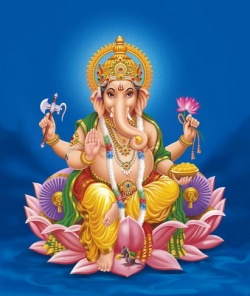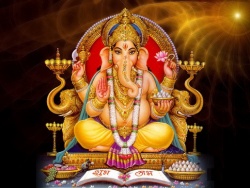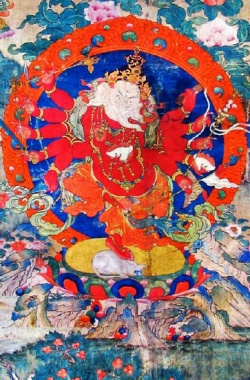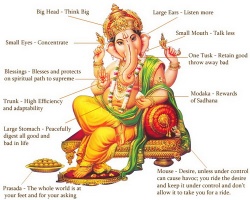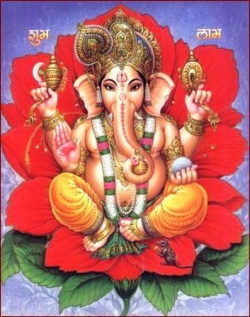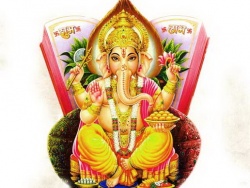Difference between revisions of "Ganesha in world religions"
| Line 55: | Line 55: | ||
[[Buddha]] as [[avatar]] of [[Ganesha]] | [[Buddha]] as [[avatar]] of [[Ganesha]] | ||
[[File:Lord-ganesh.jpg|thumb|250px|]] | [[File:Lord-ganesh.jpg|thumb|250px|]] | ||
| − | [[Buddha]] appears as a [[name]] of [[Ganesha]] in the second | + | [[Buddha]] appears as a [[name]] of [[Ganesha]] in the second verse of the {{Wiki|Ganesha Purana}} version of the [[Ganesha]] Sahasranama. The positioning of this [[name]] at the beginning of the [[Ganesha]] Sahasranama indicates that the [[name]] was of importance to the authors of that [[scripture]], who were Ganapatya [[Hindus]]. |
Bhaskararaya's commentary on the [[Ganesha]] Sahasranama says that this [[name]] for [[Ganesha]] means that the [[Buddha]] was an [[incarnation]] ([[Avatar]]) of [[Ganesha]]. This interpretation is not widely known even among Ganapatya, and the [[Buddha]] is not mentioned in the lists of Ganesha's [[incarnations]] given in the main [[sections]] of the {{Wiki|Ganesha Purana}} and Mudgala {{Wiki|Purana}}. Bhaskararaya also provides a more general interpretation of this [[name]] as simply meaning that Ganesha's very [[form]] is "[[eternal]] elightenment" (nityabuddaḥ), so he is named [[Buddha]]. | Bhaskararaya's commentary on the [[Ganesha]] Sahasranama says that this [[name]] for [[Ganesha]] means that the [[Buddha]] was an [[incarnation]] ([[Avatar]]) of [[Ganesha]]. This interpretation is not widely known even among Ganapatya, and the [[Buddha]] is not mentioned in the lists of Ganesha's [[incarnations]] given in the main [[sections]] of the {{Wiki|Ganesha Purana}} and Mudgala {{Wiki|Purana}}. Bhaskararaya also provides a more general interpretation of this [[name]] as simply meaning that Ganesha's very [[form]] is "[[eternal]] elightenment" (nityabuddaḥ), so he is named [[Buddha]]. | ||
Latest revision as of 06:36, 26 January 2014
India and Hinduism had an impact on many countries of East Asia and the Indian Subcontinent as a result of commercial and cultural contacts. Ganesha is one of many Hindu deities who reached foreign lands as a result. The worship of Ganesha by Hindus outside of India shows regional variation. The acceptance of Hindu ideas in ancient times still continue today in world religions.
Ganesha was a deity particularly worshipped by traders and merchants, who went out of India for commercial ventures. The period from approximately the tenth century onwards was marked by the development of new networks of exchange, the formation of trade guilds, and a resurgence of money circulation, and it was during this time that Ganesha became the principal deity associated with traders. he earliest inscription where Ganesha is invoked before any other deity is by the merchant community.
Jainism
Ganesha is worshipped by most Jainas, for whom he appears to have taken over certain functions of Kubera. Jaina connections with the trading community support the idea that Jainism took up the worship of Ganesha as a result of commercial connections.
The Jaina canonical literature does not mention the cult of Ganesha. The earliest literary reference to Ganesha in Jainism is in Abhidhānacitāmani of Hemachandra (c.a. third quarter of twelfth century). It refers to several appellations of Ganesha such as Heramba, Ganavigneṣa and Vinayaka and visualizes him as elephant headed, pot-bellied, bearing an axe and riding a mouse.
According to the Swetambara Jaina work, Ācāradinakara of Vardhamānasūri (c. 1412 CE), Ganapati is propitiated even by the gods to get desirable things. It is further mentioned that He is worshipped at the beginning of every auspicious ceremony and new project. This practice is still very common in the Swetambara community. The text provides procedures for the installation of Ganapati images.
The popularity is however not met with in Digambara texts. Excepting two medieval figures carved at Udayagiri and Khandagiri caves, Orissa and an early figure at Mathura, his representations are not found in any Digambara sites.
The earliest known Jaina Ganesha statue at Mathura with Jaina Yakshi Ambika(the Jaina name for Gauri). dates to about the 9th Century CE. Images of Ganesha appear in the Jaina temples of Rajasthan and Gujarat. In the tenth-century Mahavir at Ghanerav and eleventh-century temple in Osian, Rajasthan; Ganesha images are found.
Buddhism
Ganesha also appears in Buddhism, not only in the form of the Buddhist god Vināyaka, but also portrayed as a Hindu deity form also called Vināyaka. His image may be found on Buddhist sculptures of the late Gupta period. As the Buddhist god Vināyaka, he is often shown dancing, a form called Nṛtta Ganapati that was popular in North India and adopted in Nepal and then into Tibet. A dancing Ganesha is evident in the Malay archipelago in the temple of Candi Sukuh.
Tibetan Buddhism
ibetan representations of Ganesha show ambivalent views of him. In one Tibetan form he is shown being trodden under foot by Mahākala, a popular Tibetan deity. Other depictions show him as the Destroyer of Obstacles, sometimes dancing.
Ganapati, Maha Rakta (Tibetan: tsog gi dag po, mar chen. English: The Great Red Lord of Hosts or Ganas) is a Tantric Buddhist form of Ganapati (Ganesha) related to the Chakrasamvara Cycle of Tantras. This form of Ganapati is regarded as an emanation of Avalokiteshvara.
"...beside a lapis lazuli rock mountain is a red lotus with eight petals, in the middle a blue rat expelling various jewels, [above] Shri Ganapati with a body red in colour, having an elephant face with sharp white tusks and possessing three eyes, black hair tied in a topknot with a wishing-gem and a red silk ribbon [all] in a bundle on the crown of the head. With twelve hands, the six right hold an axe, arrow, hook, vajra, sword and spear. The six left [hold] a pestle, bow, khatvanga, skullcup filled with blood, skullcup filled with human flesh and a shield together with a spear and banner. The peaceful right and left hands are signified by the vajra and skullcup filled with blood held to the heart. The remaining hands are displayed in a threatening manner. Wearing various silks as a lower garment and adorned with a variety of jewel ornaments, the left foot is extended in a dancing manner, standing in the middle of the bright rays of red flickering light." (Ngorchen Konchog Lhundrup, 1497–1557).
This form of Ganapati belongs to a set of three powerful deities known as the 'mar chen kor sum' or the Three Great Red Deities included in a larger set called 'The Thirteen Golden Dharmas' of Sakya. The other two deities are Kurukulle and Takkiraja.
In depictions of the six-armed protector Mahakala (Skt: Shad-bhuja Mahakala, Wylie: mGon po phyag drug pa), an elephant-headed figure usually addressed as Vinayaka is seen being trampled by the Dharma Protector, but he does not appear distressed. In Vajrayana and cognate Buddhist art, He is depicted as a subdued god trampled by Buddhist deities like Aparajita, Parnasabari and Vignataka.
The Tibetan Ganesha appears, besides bronzes, in the resplendent Thangka paintings alongside the Buddha. In "Ganesh, studies of an Asian God," edited by Robert L. BROWN, State University of New York Press, 1992, page 241-242, he wrote that in the Tibetan Ka'gyur tradition, it is said that the Buddha had taught the "Ganapati Hridaya Mantra" (or "Aryaganapatimantra") to disciple Ananda. The sutra in which the Buddha teaches this mantra can be found here
Shinto and Shingon Buddhism
Main article: Kangiten
See also: Hinduism in Japan
In Japan, Ganesha is considered a minor deity in the Buddhist pantheon, where he is known as Shōten (聖天), Daishokangi-ten (大聖歓喜天), Kangiten (歓喜天), Ganabachi (Ganapati), Binayaka-ten ("Vinayaka") (毘那夜迦天).
Ganesha worship was brought to Japan by early Buddhists through China. In Japan the Ganesha cult was first mentioned in 806 CE. Scholars commonly date the presence of Ganesha in Japan with the age of Kukai (774- 834), the founder of the Shingon sect of Japanese Buddhism. The centrality of the worship of Ganesha or Vinayaka or Kangiten, as he is popularly called in Japan, is a distinguishing feature of this cult. The doctrines, rituals and beliefs of the sect have a number of parallels with the cult of Ganapatya.
Also called the Deva of bliss, Ganapati is invoked both for enlightenment and for worldly gains - more for the latter than the former. Kangiten - Vinayaka is offered "bliss - buns" (made from curds, honey and parched flour), radishes, wine, and fresh fruits. The offerings are later partaken in the same spirit as Hindus take prasad.
It should also be noted that in Japan that the Hindu Ganesha is displayed more than Buddha in a famous temple in Futako Tamagawa, Tokyo. In the Hozan-ji temple on Mt. Ikoma in Nara, Sho-ten is worshipped mainly by the merchants. In Osaka we have the biggest temple of Sho-ten named Kaishozan Shoenji Temple, where, besides devotees, a permanent priest offers prayers daily. A special temple is consecrated to the esoteric Twin Ganesa at the Jingoji monastery of Takao where every year worship is held in his honor.
Dr. Lokesh Chandra,Director,International Academy Of Indian Culture explains: "German scholar Philipp Franz von Siebold has written that in 1832 there were 131 shrines dedicated to the goddess (Benzaiten) and 100 to Lord Ganesha in Tokyo itself. A 12th-century temple of Ganesha in Asakusa suburb of Tokyo has been declared a national treasure of Japan."
Ganesha is worshipped as god of love by many young boys and girls for achieving success in their courtship. The old worship him for success in business, Dr Chandra said.
Kangi figures
There are more than thirty distinguishable forms of Ganesha in the Japanese iconographic tradition.
There are several dual forms. The most typical dual form is the Embracing Kangi. In this form two tall figures with elephant heads and human bodies, male and female, stand in embrace. A new concept of Vinayaka couple both elephant-headed – a unique development in the religious history of Japan. The concept of this twin form of Ganesha (with Ganeshani) could not develop in India. There are at least three variant types of Embracing Kangi figures. Orthodox Shingon Buddhism interprets the details of all three types as sophisticated allegorical symbols. Sanford believes that these orthodox Shingon interpretations, of considerable eventual importance in Japanese worship of Ganesha, developed during the Heian period in an attempt to legitimize Ganesha as a figure in Japanese Buddhism.
Buddha as avatar of Ganesha
Buddha appears as a name of Ganesha in the second verse of the Ganesha Purana version of the Ganesha Sahasranama. The positioning of this name at the beginning of the Ganesha Sahasranama indicates that the name was of importance to the authors of that scripture, who were Ganapatya Hindus.
Bhaskararaya's commentary on the Ganesha Sahasranama says that this name for Ganesha means that the Buddha was an incarnation (Avatar) of Ganesha. This interpretation is not widely known even among Ganapatya, and the Buddha is not mentioned in the lists of Ganesha's incarnations given in the main sections of the Ganesha Purana and Mudgala Purana. Bhaskararaya also provides a more general interpretation of this name as simply meaning that Ganesha's very form is "eternal elightenment" (nityabuddaḥ), so he is named Buddha.
South-East Asia
Hindus spread out to the Malay Archipelago and took their culture with them, including Ganesha. Statues of Ganesa are found throughout the Malay Archipelago in great numbers, often beside Shiva sanctuaries. The forms of Ganesha found in Hindu art of Java, Bali, and Borneo show specific regional influences. The gradual emigration of Hindus to Indochina established Ganesha in modified forms in Burma, Cambodia, and Thailand. In Indochina Hinduism and Buddhism were practiced side-by-side, and mutual influences can be seen in Ganesha iconography of that region.
Myanmar
The King of Brahmas called Arsi, lost a wager to the King of Devas, Śakra (Thagya Min), who decapitated Arsi as agreed but put the head of an elephant on the Brahma's body who then became Ganesha.
Thailand
In Thailand, Ganesha is called Phra Phikanet (พระพิฆเนศ) or Phra Phikanesuan (พระพิฆเนศวร) and is worshipped as the deity of fortune and success, and the remover of obstacles. He is associated with arts, education and trade. Ganesha appears in the emblem of the Department of Fine Arts in Thailand. Large television channels and production companies have shrines in his honour in front of their premises. Few movies or television shows begin shooting without a Hindu ritual in which prayers and offerings are made to Ganesha. There are shrines to Ganesha across Thailand. One of the most revered shrines is the Royal Brahmin Temple in central Bangkok by the Giant Swing, where some of the oldest images can be found. Other old Ganesha images can be seen throughout Thailand, including a 10th-century bronze image found at Phang-Na with both Tamil and Thai inscriptions. The Hindu temple "Wat Phra Sri Umadevi" in Silom also houses a Ganesha image which was transported from India in the late 19th Century. Thai Buddhists frequently pay respect to Ganesha and other Hindu deities as a result of the overlapping Buddhist/Hindu cosmology. He is honoured with Motaka, sweets and fruit, when business is good, and he is made ridiculous by putting his picture or statue upside down, when business is down. As lord of business and diplomacy, he sits on a high pedestal outside Bangkok's CentralWorld (formerly World Trade Center), where people offer flowers, incense and a reverential sawasdee.
Indonesia
European scholars call him the 'Indonesian God of Wisdom'. Bandung boasts a Jalan Ganesha. A Ganesha statue from the 1st century AD was found on the summit of Mount Raksa in Panaitan Island, the Ujung Kulon National Park, West Java. While we do not find temples dedicated specifically to Gaṇeśa, He is found in every Śiva shrine throughout the islands. An 11th-century CE Ganesha statue(seen in the picture below) found in eastern Java, Kediri is placed in The Museum of Indian Art (Museum für Indische Kunst), Berlin-Dahlem. The 9th century statue of Ganesha resides in western cella (room) of Prambanan Hindu temple.
Speculation related to Janus
In 1806 Sir William Jones drew a close comparison between a particular form of Ganesha, known as Dwimukhi-Ganesha, and Janus, the two-headed Roman god. Jones felt the resemblance between Dwimukhi-Ganesha and Janus was so strong that he referred to Ganesha as the "Janus of India." The Dwimukhi-Ganesha form is a very unusual depiction in which Ganesha is shown with the head of an elephant looking toward his right and a human head at his left. It was possessed of four arms. Nagar says that the Dwimukhi-Ganesha form was associated with the region around Bombay.
There was no clear claim by Jones either that Ganesha was worshipped by the Romans or how Janus could have evolved from Ganesha as a prototype (or vice versa). Another early 19th century Indologist, Edward Moor, repeated the speculation by Jones, helping to keep the Janus idea alive. Moor expanded the claims of an association based on functional grounds, noting that Janus, like Ganesha, was invoked at the beginning of undertakings, a liminal god who was the guardian of gates. Moor made various other speculations on the connection between Janus and Ganesha. These fanciful connections proposed by early Indologists no longer appear in modern academic reviews of Ganesha's history.
Ganesha is represented as having anywhere from one to five heads, so depictions with two heads are not reliable evidence of a connection with Janus. Representations of Ganesha with two heads are uncommon, and according to Nagar, textual references to the adoration of Ganesha with two heads are difficult to trace. There are no other examples of two-headed forms in which one head is human other than the Dwimukhi-Ganesha form. In the thirty-two mediation forms of Ganesha that are described in the Sritattvanidhi only one has two heads (Dwimukhi Ganapati, the Ganapati with two faces), and both of those are heads of elephants, like all the other forms described.
